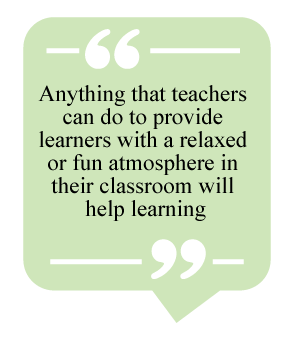 Experienced language teachers have always had strong intuitions about what works and what does not work in the classroom. Recent neurolinguistic research is not only confirming what we already know, but revealing much needed detail about how to use our increasing knowledge to optimize language learning.
Experienced language teachers have always had strong intuitions about what works and what does not work in the classroom. Recent neurolinguistic research is not only confirming what we already know, but revealing much needed detail about how to use our increasing knowledge to optimize language learning.
Getting to Long-Term Memory
A basic understanding of how new language makes its way from the classroom into long-term memory is very helpful in understanding which classroom practices are effective. The process begins in the learners’ sense organs—for example, their eyes and ears. Input from the sense organs is transmitted to the sensory portals, such as the visual cortex, which are in the rear or lower areas of the brain (Kemmerer, 2015). Then, the information is sent forward to the prefrontal cortex.
Language Teaching Implications: For teachers, an implication of this process for learning is that classroom activities that involve multiple senses will be more effective than those that do not. The more information that is sent from the sensory portals to the prefrontal cortex, the richer the learning will be. For example, a lesson in which learners are studying the names of various fruits and vegetables will be much more effective if the learners can see, smell, hold, and even taste real bananas, carrots, and potatoes.
In the prefrontal cortex, the new language enters working memory, a kind of holding area. Its capacity is extremely limited and only temporary (Bailey & Pransky, 2014). For classroom instruction, the consequence of giving learners a great deal of new language in a short period of time is an overwhelmed working memory.
Language Teaching Implications: When teaching daily actions—for example, the phrases wake up and eat lunch, the lesson can quickly lead to cognitive overload because the learners are dealing with the meaning of new vocabulary, multipart verbs, and the third-person verb conjugation. Dealing with one of these concepts at a time may alleviate the problem of overload.

From the prefrontal cortex, the new language enters a phase of memory consolidation that involves the hippocampus and the amygdala, in the temporal lobes of the brain. fMRI research has shown that all three of these areas are involved in consolidating memories, but neuroscientists are still not certain of the exact process. What is certain is that the hippocampus plays a critical role as a kind of traffic cop, steering information into long-term memory in various parts of the neocortex, the grey matter of the brain. The amygdala is an emotional center, activated by the emotional aspects and personal significance for the learner of new language. One of the conclusions that has become more and more pronounced in hippocampal research is the importance of rest, silence, exercise, and sleep for memory consolidation.
Language Teaching Implications: Most of us have known that cramming before a test is an ineffective way to learn. Short periods of study followed by short periods of relaxation or sleep are best for learners (Kent & Mistlberger, 2017).
Emotions: The Amygdala
Research into the amygdala has produced similar insights for teachers. Lessons that have personal significance or an emotional impact will have a much better chance of forming strong memory traces in the neocortex.
Language Teaching Implications: In the lesson on food mentioned previously, if the teacher asks learners personal questions about the food in the lesson, it will stimulate the amygdala. Which foods do the learners like to eat? If they were planning a meal for their family, what would the various dishes be? (Tying, Amin, Saad, & Malik, 2017)
One other function of the amygdala can have negative implications for learning. The amygdala is closely involved in the release of stress hormones—for example, cortisol and adrenaline. Moderate amounts of these are beneficial for learning. Severe stress, however, causes less detailed encoding of new language and faulty integration of new language with existing. Chronic stress can even cause damage to the hippocampus and premature brain aging.
Language Teaching Implications: Anything that teachers can do to provide learners with a relaxed or fun atmosphere in their classroom will help learning (Vogel & Schwabe, 2016).
Developing Long-Term Memory: Neurons
Solidifying New Language in Memory
Once new language has passed through the hippocampus and amygdala and entered the neocortex, the process of learning is not finished. Getting information or memories to your learners’ grey matter is just the first part of a sophisticated process. Unless the learners reuse this new language over an extended period of time, their memories will decay, what has been learned lost. This is because all memories are encoded in networks of neurons, the basic cells of the nervous system (Kemmerer, 2015). When neurons in a network fire together, the connections between them become faster and closer to being permanently wired, hence Donald Hebb's famous expression, “Neurons that fire together wire together.”
Recursive Hierarchical Recognition
Lance Knowles, cofounder of DynEd International, created an educational methodology called recursive hierarchical recognition (RHR; Knowles, 2008) Using recursive as a benchmark is a useful diversion from repetition, which may make teachers think of drill-and-kill activities. In the food activity previously described, the vocabulary for different foods can be presented in a variety of interesting activities—for example, talking about favorite foods, discussing preparation of favorite dishes, or ordering food in restaurant role-plays. As the students move from one food-related activity to the next, their neural networks for food language solidify.
This need for multiple exposure to new language plays to the strength of digital courseware. When learners interact one-on-one with software that has even a minimal level of artificial intelligence, the courseware can provide a level of recursive exposure that suits each learner. In blended programs, later communicative activities with a teacher or coach will help learners develop their ability to use what they have learned.
Language Teaching Implications: For classroom teachers, the implications of this process are clear. Learners need multiple exposures to new language over an extended period of time. One point to emphasize, however, is that multiple exposures does not necessarily entail rote memorization or simple repetition. To be effective, a teacher or digital courseware should introduce new concepts and content in a variety of relevant contexts, recursive rather than repetitive.
Long-Term Memory Systems
Often of intensive concern to language teachers is their students’ desire to reach a proficiency level in a second language that is reasonably close to the level of native speakers of that language, a C1 or C2 on the CEFR scale. To do that, teachers must also have a basic familiarity with the two major long-term memory systems: declarative memory and procedural memory (Ullman, 2015).
Declarative Memory
Declarative memory is used primarily for explicit knowledge—for example, learning facts or remembering events. In language learning, it is a critical factor in the ability to learn new words in an L2, including words’ forms and pronunciation. It is triggered by explicit instruction—for example, a language lesson in which students study grammar rules or idioms. Learning is relatively rapid in this system, but involves conscious effort and time during memory retrieval, which prevents language learners from reaching a high level of fluency. Children’s ability to use this memory system is rather weak, but improves as they age until they depend heavily on it as adults.
Procedural Memory
Procedural memory is closely related to the parts of the brain used for movement, such as the motor cortex. From an evolutionary perspective, this system likely predates declarative memory and evolved with humans as language became more important. Children rely almost entirely on procedural memory. Learning with procedural memory is slower than with declarative memory, but you can use procedural knowledge without conscious thought. For example, if you ride a bicycle, you do not have to think about what your legs are doing, which is why this knowledge is often referred to as having been acquired, rather than learned. Procedural memory is extremely important for using the target language with a high level of automaticity. Researchers have also identified procedural memory as being of critical importance in high-level uses of language—for example, understanding sequences, making predictions, and categorizing.
Recent research suggests that when learners use declarative memory in language classes—for example, by learning explicit grammar rules, it hinders procedural memory. Interactive digital courseware can provide the deep exposure to language patterns that reinforce procedural memory.
Language Teaching Implications: For instructors, there are some clear implications. To attain a high level of proficiency in a second language, a methodology which focuses on procedural memory is more effective, especially for young learners. To achieve this, teachers need to provide intensive or immersive exposure to the target language and allow extensive time for acquisition of the new language. Learners need to use the second language, rather than study about it. An inductive methodology may take more time, but pays off richly in the long term.
Neurolinguistic insights have multiplied in recent decades because of our increased ability to directly examine cognitive processes. This knowledge for the most part confirms what experienced language teachers have always known: Learning a second language requires diligence and time, with intensive exposure to the target language in an engaging, relevant, communicative context. Armed with this knowledge, we can provide a more effective learning environment.
References
Bailey, F., & Pransky, K. (2014). Memory at work in the classroom. Alexandria, VA: ASCD.
Kemmerer, D. (2015). Cognitive neuroscience of language. New York, NY: Psychology Press.
Kent, B. A., & Mistlberger, R. E. (2017). Sleep and hippocampal neurogenesis: Implications for Alzheimer’s disease. Frontiers in Neuroendocrinology, 45, 35–52
Knowles, L. (2008). Recursive hierarchical recognition. In FEELTA/NATE Conference Proceedings (pp. 28–34).
Tying, C. M., Amin, H. U., Saad, M. N., & Malik, A. S. (2017). The influences of emotion on learning and memory. Frontiers in Psychology, 8. doi:10.3389/psyg.2017.01454
Ullman, M. T. (2015). The declarative/procedural model: A neurobiologically motivated theory of first and second language. In B. Van Patten & J. Williams (Eds.), Theories in second language acquisition: An introduction (2nd ed; pp. 135–158). New York, NY: Routledge.
Vogel, S., & Schwabe, L. (2016). Learning and memory under stress: Implications for the classroom. npj Science of Learning, 1(1). doi:10.1038/npjscilearn.2016.11
|
Download this article (PDF) |
Kevin McClure is DynEd International’s artificial intelligence and assessment lead. He has a master's degree in applied linguistics and 36 years of experience in all aspects of English language teaching. He has authored three listening and speaking textbooks and has lived and worked extensively in France, Japan, and China. He has been in the field of online English teaching for 20 years.
| Next Article |